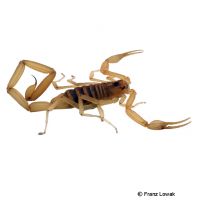Arizona Bark Scorpion (Centruroides exilicauda)
| Arizona Bark Scorpion Centruroides exilicauda | |
|---|---|
| Name | Arizona Bark Scorpion |
| Name Lat. | Centruroides exilicauda |
| Family | Fat-tailed Scorpions |
| Family lat. | Buthidae |
| Order | Scorpions |
| Order lat. | Scorpiones |
| Origin | North America |
| Habitat | Desert, semi-desert |
| Diet | Live insects |
| Humidity | 40-60 % |
| Behavior | Nocturnal, aggressive |
| Keeping | Individual, pair, group |
| Care Level | Difficult |
| Housing | Dry terrarium |
| Breeding | Moderately difficult |
| Life Span | 1-2 years |
| Protection | No |
| Metric Units | |
| Size | 6-8 cm |
| Temperature Day | 28-32 °C |
| Temperature Night | 20-22 °C |
| Housing Size | 30 x 30 x 30 cm |
| US Units | |
| Size | 2.4"-3.1" |
| Temperature Day | 82-90 °F |
| Temperature Night | 68-72 °F |
| Housing Size | 10" x 10" x 10" |
Distribution and habitat
Arizona bark scorpions are widely distributed in the southwestern United States, from Nevada, Utah, Arizona, California, and New Mexico to adjacent northwestern Mexico. These non-burrowing scorpions live in deserts and semi-deserts, where they hide under rocks and tree bark during the day. They occur in various color forms, with or without markings.
Maintenance
For 1 animal a terrarium of L 30 x W 30 x H 30 cm can be recommended. For a pair or group keeping the terrarium must be extended accordingly. The terrarium should be placed in a quiet and vibration-free place without sunlight.
You need a terrarium structured with cork tubes, pieces of bark, roots and stones (hiding places and visual protection), an approximately 7 cm deep substrate of sand-earth mixture, a small, shallow drinking vessel and for decoration artificial or potted plants (e.g. Ficus pumila, Scindapsus aureus). A small part of the substrate, especially the lower layers, should always be kept slightly moist. Once or twice a week the inside of the terrarium should be finely sprayed with water, but not the animals (danger of shock)
| Temp. day: 28-32 °C | Temp. night: 20-22 °C | Humidity: 40-60 |
The lighting duration should be 8-12 hrs. depending on the season, but is not absolutely necessary for the nocturnal animals. Attention should be paid to their natural day-night rhythm.
Diet
The diet consists of crickets, cockroaches, house crickets, maggots and grasshoppers as well as other arthropods. Wax moths should only be fed in small quantities to adults, but not to juveniles, because of their large fat content
Using fruit and honey water as food for the foragers can enhance their quality. It is important to add minerals and vitamins regularly (dusting the feed animals). Young animals should be offered food daily, adults 1-2 times a week. Feeding should be done only in the evening. Hungry scorpions keep their pedipalpal claws wide open and actively search for food. Drinking water must always be available
A varied diet promotes health and prevents deficiency symptoms.
Reproduction and breeding
The sex difference is difficult to see. The sexual opening is heart-shaped in the female, oval in the male. Males appear somewhat more slender.
During the "mating dance", which is similar to a wrestling match, a sperm package (spermatophore) is passed. Females can also give birth to offspring several times without further mating (sperm storage). After a gestation period of 4-8 months, the female gives birth to the young. The white, barely mobile young find protection from predators on the back of the mother for at least 2 weeks, until after the 2nd molt. Only then do they begin to feed on their own. Small crickets and house crickets are suitable as rearing food.
Obligation to report
Make sure to inform yourself about any regulations on keeping or bans on keeping this animal in your state or home municipality (e.g. public order office). Your pet store will be happy to provide you with further information.
Important
Pair or group housing is well possible.
Great caution is required when handling them in the terrarium. They are very aggressive and belong to the most poisonous scorpions. Their sting is very painful and can have a life-threatening poisonous effect on children and adolescents!
For transferring the animals are grabbed with approx. 30 cm long feeding tweezers at the rear end and not at the front body (risk of injury)
Good ventilation without drafts and equipment for measuring temperature and humidity are necessary. Lighting should be placed in such a way that the animals cannot injure themselves. The terrarium should be locked in such a way that neither unauthorized persons can open it nor the animals can escape. Special attention should be paid to thorough hygiene and impurities must be removed regularly
Further literature can be found in your pet store.
References
Text: petdata; Image: Franz Lowak
Source: ENGELMANN & LANGE (2011): Zootierhaltung - Tiere in menschlicher Obhut: Wirbellose, Harri Deutsch Verlag; WATZ (2008): Skorpione im Terrarium, Verlag Ulmer
